Identifying lizards is similar to identifying any living thing, knowing their geographic ranges can help you narrow down the species.
That being said it doesn’t make it super easy since there are several thousands of lizard species all around the world.
From there you can easily find out the species. However with pet lizards, this method isn’t always a viable option as these pets usually aren’t situated within their geographic range.
With this, identifying features can be used to determine the species. Things such as the skin, skin colorations and other features that stand out can be used to determine the lizard’s species and name.
For example, the veiled chameleon can be easily identified by the casque (cone) on its head. Similarly, the blue-tongued skink can be identified by its long blue tongue.
Identifying a Lizard
Lizards belong to the order Squamata which also include snakes and amphisbaenia. Lizards range from geckos, agamids, even komodo dragons.
Geographic Range
The geographic range of the reptile really narrows down the species. The geographic range refers to where it is natively from. The geographic range can be very limited or even span entire subcontinents.
Determining the geographic range of an unknown pet reptile can be tough. However if it is a wild reptile then it is almost definitely located within its geographic range, Of course, some pet lizards that get released into the wild (please never do this) can successfully establish a wild population in an area that they aren’t endemic to.
Coloration & Pattern
Lizards come in a wide variety of colors and patterns. Some lizards may be spotted while others may be evenly colored. The coloration goes a long way in determining the species. For instance, the coloration of a leopard geckos skin resembles that of a leopard. That is a yellow background with dark spots.
Size & Shape
The length and weight of a lizard can help you to identify the lizard. Some lizards are huge by nature while others are tiny. These are important characteristics when it comes to identification.
Also distinguishing features such as the shape of the head and the present of cranial bumps can all help to identify the lizard. In this article, I have identified several distinguishing features that can help you to quickly identify the species of several commonly kept pet lizards.
Identifying Some Common Pet Lizards
Here is how to identify some of the most popular lizards kept as pets. These species are from all over the world and not just one geographic range.
Leopard Gecko
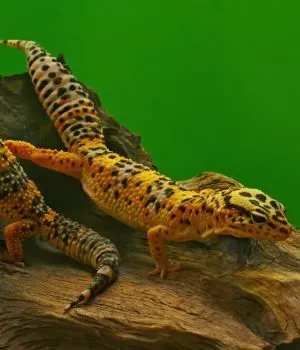
The scientific name of this reptile is Eublepharis macularius. This is one of the most common lizards kept as pets. They are easy to care for and gorgeous.
Color & pattern: These lizards have spotted coloration. The background color is yellow and the spots are black. Due to the presence of morphs, some leos may have very few spots.
Size: These geckos grow to lengths of 7 to 11 inches. Females are shorter, reaching lengths of 7 to 8 inches and weights of 60 to 70 g. Males reach lengths of 8 to 11 inches and weights of 60 to 80 g.
Distinguishing Feature: This lizard has spots and coloration similar to that of a leopard.
Geographic range: These lizards are endemic to Pakistan, Northwest India, Iran, Iraq, and Afghanistan.
Habitat: They live in arid regions such as deserts, and arid grasslands.
Bearded Dragon
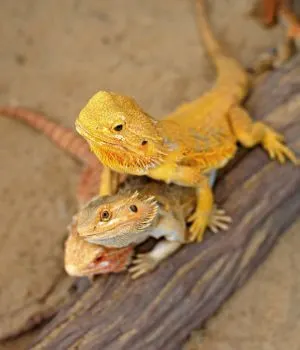
The bearded dragon is another popular lizard kept as a pet. This dragon can grow to lengths of 24 inches (which is 2 feet). As you can see they are quite large. The scientific name of this reptile is Pogona vitticeps.
Color & pattern: The color of this species isn’t constant. Depending on the region where they are found, they may be tan with red highlights, brown with red highlights, or even yellow highlights.
Size: These dragons can grow to lengths of 24 inches.
Distinguishing Feature: Bearded dragons are easily recognized by their beard. This is a spiky pouch under their throat. It looks like a spiky short beard. They also puff out this throat when scared or stressed.
Geographic range: These dragons are endemic to central and eastern Australia.
Habitat: They inhabit arid regions such as dry forests and grasslands, savannas, and deserts.
Mourning Gecko

This gecko is also known as the common smooth-scaled gecko. The scientific name of this reptile is Lepidodactylus lugubris.
Color & pattern: The mourning gecko is cryptically colored. This allows them to blend into their native environment. Their coloration can change throughout the day as such their color may be dark or light depending on the time of day.
They are tan with darker spots. Their head features a brown stripe that goes from their nose to their ear. They also have zig-zag patterns on their back.
Size: These geckos grow to lengths of 3.5 to 4 inches or 8.5 to 10 cm. This is their average adult size.
Distinguishing Feature: The brown strip that does from each nostril their ear on both sides can be used to distinguish them. They also have zig-zag patterns on their back.
Geographic range: They are endemic to the coastal regions of both the Pacific and Indian oceans. They can also be found in the tropics of several Central and South American countries as well as Seychelles in Africa.
Gargoyle Gecko
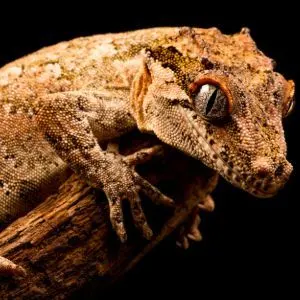
The scientific name of this reptile is Rhacodactylus auriculatus.
Color & pattern: The gargoyle gecko comes in several colorations such as reds, orange, yellows, browns, and greys with a variety of patterns such as blotches and stripes. They can, however, be easily distinguished by the cranial bumps on their heads that make them look like gargoyles.
Size: The gargoyle gecko generally grows to lengths of 7 to 9 inches or 18 to 23 cm. They also generally weigh 60 to 70 g or 2 to 2.5 oz.
Distinguishing Feature: These geckos can be distinguished by the bumps on their heads. These bumps look like ears or even horns.
Geographic range: These lizards are endemic to New Caledonia.
Habitat: These geckos live in forest zones.
Gold Dust Day Gecko
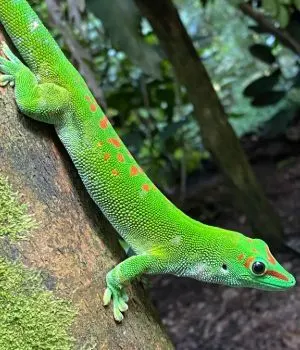
The gold dust day gecko is native to Madagascar and the Comoros island. However, they can also be found extensively in Hawaii. The scientific name of this reptile is Phelsuma laticauda.
Color & pattern: The gold dust day gecko is yellowish-green or bright green with red speckles on their neck, head, and lower back. Upon close inspection, you can notice what seems like gold dust sprinkles on their tail, limbs, and neck.
Size: These day geckos reach a length of 6 to 9 inches or 15 to 22 cm.
Distinguishing Feature: Upon close inspection, you can notice what seems like gold dust sprinkles on their tail, limbs, and neck. They also have red speckles on their head, neck, and lower back.
Geographic range: They are endemic to Comoros and Madagascar. However, they have been introduced to Hawaii.
Habitat: These geckos live in forests and areas with high humidity.
Crested Gecko
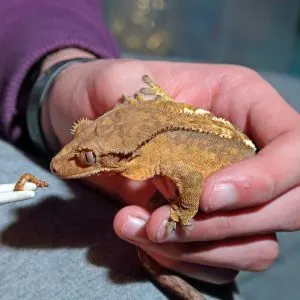
The scientific name of this reptile is Correlophus ciliatus or Rhacodactylus ciliatus. Crested geckos are also known as the New Caledonian gecko. As you can imagine, they are endemic to New Caledonia.
Color & pattern: Their dorsal surface is reddish-brown, peach, or light tan.
Size: They grow to an average adult length of 8 inches or 20 cm. They also weigh 1 to 1.2 oz or 30 to 35 grams as adults.
Distinguishing Feature: These lizards have calcareous crests above their eyes, on parts of their limbs, and along their back (on either side).
Geographic range: They can be found in New Caledonia, particularly the Isle of Pines and Grand Terre.
Habitat: These geckos inhabit tropical rainforests.
Veiled Chameleon

The binomial name of this reptile is Chamaeleo calyptratus. This chameleon is also known as the Yemen chameleon (since the species is endemic to Yemen) and the cone-head chameleon.
Color & pattern: The background color of this reptile is green. Stripes and patterns of blue, yellow, black, and orange can also be found on their skin.
Size: Males reach lengths of 17 to 24 inches while females reach an average adult length of 14 inches.
Distinguishing Feature: These chameleons have a casque on their heads. This looks like a cone which gives them their common name: cone-head chameleon. This casque gets bigger the more the lizard matures.
Geographic range: These lizards can be found on the Yemen-Saudi Arabia border.
Habitat: These chameleons inhabit the desert, forests, and mountainous regions of southern Yemen and Saudi Arabia. They are arboreal and as such are almost always found in trees and shrubs.
Uromastyx

The common name of this reptile is the spiny-tailed lizard. Uromastyx refers to the lizards in the genus. These vegetarian lizards are quite commonly kept as pets.
Color & pattern: Like several other lizards, the Uromastyx can change color depending on temperature. When temperatures are low, they turn dull and dark in color.
However, when the weather is warm, they turn lighter in color. This is to regulate sunlight absorption. When there is less sunlight, temperatures are cooler, and as such the darker color allows them to absorb more sunlight.
Size: These reptiles can be quite large even reaching lengths of 36 inches or 3 feet. Expect an adult Uromastyx to reach lengths of 10 to 36 inches or 25 to 91 cm.
Distinguishing Feature: They have large strong spiky tails which they swing with velocity. They can cause injuries with their powerful tail. They are also quite large.
Geographic range: The Uromastyx is endemic to North Africa and the Middle East.
Tokay Gecko

The scientific name of this reptile is Gekko gecko. This gecko is named after its mating call which sounds like “gek-gek”, “token”, or “poo-kay”.
Color & pattern: The skin coloration is usually gray with red spots which can darken or lighten depending on its mood. This lizard can darken and lighten the entire coloration of its skin.
Size: Among geckoes the tokay gecko is huge. It is considered to be among the largest.
Distinguishing Feature: This gecko is grayish with a lot of red speckles/spots. Juveniles are more brownish but the red spots are still visible.
Geographic range: These lizards can be found in India, Nepal, Bhutan, Thailand, Malaysia, the Philippines, and even Indonesia.
Habitat: These geckos are arboreal and can be found on trees and high cliffs in rainforests.
Call: https://www.youtube.com/watch?v=jpTuZ5oteqo
Blue-Tongued Skink

The scientific name of this reptile is Tiliqua scincoides. They are called blue-tongued skinks because they are skinks with blue tongues.
Color & pattern: The blue-tongued skink has a long blue tongue which makes identification easy. Its back is pale brown with streaks of dark brown and gray. Its underside is lighter in color (grayish).
Size: This skink grows to an average adult length of 13inches or 33 cm and reaches weights of about 17 oz or 500 grams.
Distinguishing Feature: This lizard can be easily identified by its long blue tongue.
Geographic range: These skinks are endemic to Tasmania, New Guinea, and Australia.
Habitat: These normally live in scrub forests, mixed woodland, semi-arid deserts, and grasslands of Tasmania, New Guinea, and Australia.
Conclusion
There are countless lizard species in the world, some of which include dragons, geckos, chameleons, and even skinks. Many of these lizards have made it onto the pet scene. The identification of these exotic reptiles can be quite tricky.
And why does identification even matter? Identification can allow you to identify the best care for the reptile. You can then research and find out a lot of important care information such as whether or not the reptile is herbivorous or carnivorous, the required humidity levels of the lizard’s enclosure.
You can use the physical characteristics to identify the reptile, this includes the size, distinguishing features, and even the coloration and patterns on the specimen’s skin.
While we are unable to cover every single lizard in this article, we have covered the 10 most popular lizards kept as pets. These are the lizards you are most likely to come across.
Leave a comment, if you have any additional information or questions.
Table of Contents
